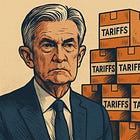Cutting Rates Into Sticky Inflation
The Fed signals surrender as core prices refuse to budge.
If the Fed cuts this week, it won't be because the data says cut. It'll be because the Fed talked itself into a corner and is now trying to save face.
Inflation is sticky, growth is hot, and yet Wall Street wants a pacifier. The central bank looks ready to oblige.
Markets are pricing a near-certain trim on the back of soft payrolls and a higher unemployment rate. But zoom out and the dashboard is flashing hold.
Core CPI ~3.1%, core PCE ~2.9%, GDP running 3.3%—all above a 2% inflation target and potential-growth speed limits.
In plain English: still too much heat to be slashing rates.
Let's deal with the jobs narrative first. August payrolls were a measly +22,000, June was revised to an outright loss, and the BLS says the economy created 911,000 fewer jobs through March than initially reported.
That's a big, embarrassing miss.
But here's the thing: if the jobs market was cooler all along while core inflation stayed near 3%, then the overheating labor market narrative was a crutch. And cutting now won't fix a structural inflation problem.
Powell himself framed the labor picture as a curious kind of balance driven by slower demand and slower supply. Tighter immigration reduces the breakeven jobs needed to keep unemployment steady.
Translation: +22,000 isn't great, but it's not a recession siren by itself. Cooling was the point of a restrictive stance. Calling it a crisis now is revisionist.
August CPI re-accelerated. Services inflation, where monetary policy actually bites, keeps grinding. The core PCE trend has been moving the wrong way, nudging up month after month.
Add tariffs pushing through to goods prices and you've got the worst possible moment to validate higher inflation with easier money.
The real economy isn't begging for a rescue, either. Q2 growth was revised up to 3.3%, consumer spending is still advancing, incomes are rising. Powell said banks see consumers in solid shape with delinquencies not a general problem.
Cutting into strength is how you stoke demand when supply is the choke point. That's how you re-anchor inflation high.
So why are traders so confident a cut is coming? Because the Fed shifted its tone. Hard.
In July, Powell called policy modestly restrictive, noting the economy wasn't acting like rates were strangling it. After a couple weak labor prints, Jackson Hole turned dovish:
Downside risks to employment are rising and conditions may warrant adjusting our policy stance.
Markets heard the dog whistle.
This is the communications trap: do you do the right thing and risk a market tantrum, or the expected thing and risk your inflation-fighting credibility? We've been here before, and we know how it ends. Volatility either way.
The bigger danger isn't a few red candles. It's telling households and firms, implicitly, that 3%-ish inflation is good enough. Once expectations drift, getting them back is expensive.
Rules would have prevented this farce. A simple Taylor-style rule using current data says: hold. Or even nudge up. One calculation that bakes in policy inertia and the latest 3-month inflation prints pegs the optimal funds rate around 4.52%, a hair above today's 4.25%–4.50% range. Another Taylor application spits out around 4.1%.
Basically don't ease.
Either way, the machines don't see a case for a cut. Humans, apparently, do.
It's not just one rule. A suite of simple policy rules compiled by Cleveland Fed researchers cluster right around the current stance, with a wide uncertainty band. When models disagree this much, real risk management argues for patience, not a headline-chasing pivot.
Hold, watch the data, reassess. That's grown-up central banking.
One more inconvenient detail: productivity. If output is ripping while hours and headcount stall, that means workers are producing more per hour. A productivity-led expansion is less inflationary than a sugar-high demand boom.
Cutting into a productivity rebound is like tapping the gas as the road finally straightens. You might not crash, but why play stupid games?
Tariffs complicate all of this. Powell calls them a one-time shift in the price level. Maybe. But if you ease into that shock, you don't just absorb it—you ratify it. Businesses and unions will read the signal and price accordingly.
That's how a one-time bump turns into a new normal.
Here's the blunt summary the Fed won't say out loud: A cut now would be an error of commission, validating markets and politics over the mandate. Holding too long would be an error of omission, but one you can quickly correct if the data actually rolls over.
Only one of these errors torches credibility and risks re-accelerating inflation.
The way out isn't mystical. Do a hawkish hold. Say the quiet part: inflation isn't sustainably at target, growth is above potential, labor is rebalancing, and we'll cut when the data demand it. Not when futures traders do.
Then stop freelancing vibes guidance and anchor policy to rules that everyone can read and front-run with their spreadsheets.
Because the bigger picture isn't this meeting. It's whether Americans believe 2% still means 2%, or whether the Fed's data-dependence is just code for we'll wing it until the S&P squeals.
If it's the latter, we're not managing the economy. We're managing expectations until they manage us.



